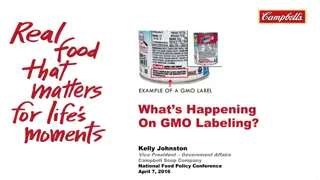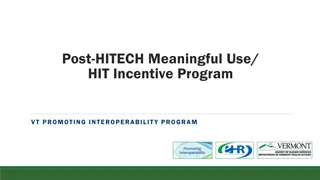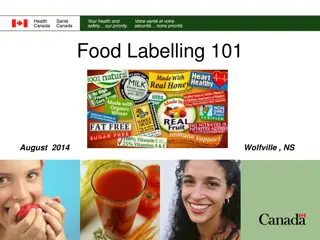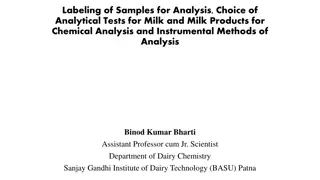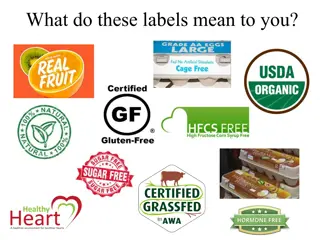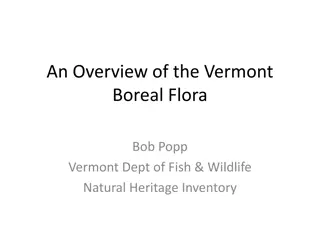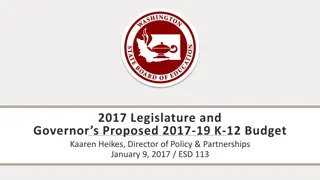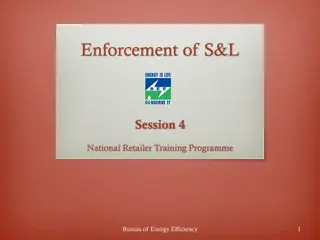Legislative Updates on GMO Labeling and Legal Compliance in Vermont
Mandatory GMO labeling legislation requiring disclosure of bioengineered ingredients, enforcement of Vermont Labeling Law since July 1, 2016, and guidelines for foods certified as not produced with genetic engineering in Vermont. The Attorney General provides guidance on compliance, including the need for sworn statements and independent verification for GE crops. Stay informed to meet legal requirements effectively.
- GMO Labeling
- Legislative Updates
- Vermont Law
- Genetic Engineering Compliance
- Attorney General Guidance
Download Presentation

Please find below an Image/Link to download the presentation.
The content on the website is provided AS IS for your information and personal use only. It may not be sold, licensed, or shared on other websites without obtaining consent from the author. Download presentation by click this link. If you encounter any issues during the download, it is possible that the publisher has removed the file from their server.
E N D
Presentation Transcript
ASTA Legislative and Legal Concerns Committee & OSA Legislative Committee
GMO Labeling Legislation Mandatory disclosure of bioengineered ingredients via QR code, on pack words or symbol (plus 1-800 number for small companies) Definition of bioengineered does not include gene editing Broad pre-emption for food and seed from state GMO labeling laws Implementation timeline Secretary of Ag determines: Threshold for what must be labeled
Vermont Labeling Law Takes effect July 1, 2016 Improperly labeled foods must have been packaged and distributed to the retailer prior to July 1, 2016. No extension of time to come into compliance after July 1, 2016.
GE Crops Only certain crops have known varieties that are or have been produced with genetic engineering. These are listed, below*. If a food product offered for retail sale in Vermont is, or contains an ingredient derived from, one of the crops listed below, it is likely subject to the labeling requirements of CP 121.02. Alfalfa Apple Canola Cantaloupe Chicory Corn Cotton Flax Papaya Plum Potato Radicchio Rice Soybean Squash Sugar Beet
Foods Certified as Not Produced with Genetic Engineering (i) Food for which the person otherwise responsible for complying with section 121.02 of this rule obtains a sworn statement from whomever sold the food to that person. The sworn statement must affirm that the food (1) was made or grown from food or seed that has not been knowingly or intentionally produced with genetic engineering and (2) has been segregated from and has not been knowingly or intentionally commingled with food or seed that may have been produced with genetic engineering. (ii) When providing a sworn statement under this rule, a person may rely solely on a sworn statement that contains the above affirmation by whoever sold the food to that person.
Vermont Attorney General Guidance 20. If there are no GE variations of a product s ingredient available in the marketplace, is independent verification or a sworn statement necessary? No. The Attorney General s Office maintains a periodically updated list of known GE crops. If the product s ingredient does not appear on this list, the retailer or manufacturer responsible for labeling should keep a copy of the list as sufficient documentation to demonstrate compliance with the law. See CP 121.04(b) http://ago.vermont.gov/focus/consumer-info/fuel/ge-food- labeling-rule/guidance-and-faqs.php#Manufacturers
Non-GE Certification If the crop is on the list Food manufacturer must use either an approved certifier (non-GMO project or True North) to prove that a product is non-GE or Have sworn statements from suppliers
Vermont Labeling Requirement Disclosures on packaged, processed foods shall read Produced with Genetic Engineering, Partially Produced with Genetic Engineering, or May be Produced with Genetic Engineering, (A)The disclosure Produced with Genetic Engineering shall be used when food was produced with genetic engineering (B) Partially may be used to modify Produced with Genetic Engineering only when a processed food contains less than 75% genetically engineered material by weight; And more than 0.9 % of the total weight of the food. (C) May be may be used to modify Produced with Genetic Engineering only when the food s manufacturer does not know, after reasonable inquiry, whether the food is, or contains a component that is, produced with genetic engineering..
Located on the package so as to be easily found by consumers when viewing the outside of the package. Such disclosures shall be in any color that contrasts with the background of the package so as to be easily read by consumers, and shall be either: (1) in a font size no smaller than the size of the words Serving Size on the Nutrition Facts label, (2) in a font size no smaller than the Ingredient List required and printed in bold type-face. A disclosure that satisfies the font and color requirements of this rule and is located on the same panel as the Nutrition Facts Label or Ingredient List shall be presumed to satisfy the easily found requirement.
International Treaty Letter of support from 81 organizations and companies Including: American Farm Bureau Federation American Phytopathological Society American Soybean Association American Society of Plant Biologists National Association of Plant Breeders and National Council of Commercial Plant Breeders National Association of Wheat Growers National Corn Growers Association National Cotton Council National Council of Commercial Plant Breeders National Farmers Union National Sorghum Producers USA Rice
Hearing on May 19, 2016. ASTA was represented by John Schoenecker, HM.CLAUSE Treaty Ratification Timeline Pending in the Senate since 2008. Vote in Foreign Relations Committee Thursday
Food Safety Modernization Act Who is potentially impacted? Primary focus, as related to the seed industry Seed companies that sell discarded seed into feed channels (or to grain elevators) 13
FDA Guidance on Registration FDA GUIDANCE ON REGISTRATION 14
Food Safety Modernization Act Animal Feed Rule Creates new regulations for registered facilities (21 CFR Part 507) Preventative Controls - Food safety plans and their implementation Current Good Manufacturing Practices (GMPs) Without an exemption, seed facilities could fall under same regulations used for traditional feed operations Primary requirements to comply would be GMPs and Preventive Controls 15
Overview of GMPs GMPs address Personnel Plant and grounds Sanitation Water supply and plumbing Equipment and utensils Plant operations Holding and distribution 16
Overview of Preventive Controls Conduct hazard analysis Identify and implement preventive controls Manage preventive controls Monitoring Verification Validation Corrective Actions DOCUMENT EVERYTHING! 17
Still Waiting for Final Guidance from FDA on Exemption Status Supplemental notice of proposed rulemaking Final rule Questions to Technical Assistance Network (TAN)
Supplemental notice of proposed rulemaking (September 2014) In the preamble, FDA states: With this revised definition of holding, facilities such as grain elevators and silos would, in most cases, satisfy the criteria for the proposed exemption for facilities solely engaged in the storage of RACs (other than fruits and vegetables) intended for further distribution or processing (proposed 507.5(g)), because the definition would encompass activities performed as a practical necessity for the distribution of RACs. Other facilities that conduct operations similar to those conducted at grain elevators and silos, such as facilities that package and sell seed for crops, but sell the leftover seed for animal food, also may satisfy these criteria for exemption.
Final Rule (December 2015) On-farm harvesting activities are exempt. Certain harvesting activities done at a facility that isn t owned by a farm may not be exempt (i.e. shelling corn, ginning cotton) Activity-specific (vs. practical necessity for storage of raw agricultural commodities in supplemental) so the situation for seed operations is unclear! 20
ASTA has Sought Official Guidance Meeting with FDA on February 9, 2016 Questions submitted to FDA March, 2016 Clarify what activities are allowed under holding as a practical necessity for distribution of seed . Registration for exempt facilities Training requirements for exempt facilities Are there different regulations for harvesting activities at non-farm facilities.
Current Status..Waiting What FDA has told us Preamble is most official guidance for now Vegetable seed is not considered a vegetable Answers to questions are coming sometime Farm guidance is coming sometime Seed conditioning facilities are low risk
COMPLIANCE DATES Business Size CGMP compliance date PC compliance date Business other than small and very small September 17, 2016 September 17, 2017 Small business (a business employing fewer than 500 full- time equivalent employees) September 17, 2017 September 17, 2018 Very small business (a business averaging less than $2,500,000, adjusted for inflation, per year, during the 3-year period preceding the applicable calendar year in sales of animal food plus the market value of animal food manufactured, processed, packed, or held without sale (e.g., held for a fee or supplied to a farm without sale). September 17, 2018 September 17, 2019, except for records to support its status as a very small business (January 1, 2017) 23
BILL versus REPORT language BILL: High-level overview of appropriations for agencies. Text Example: For necessary expenses of the Office of the Chief Economist, $16,777,000, of which $4,000,000 shall be for grants or cooperative agreements for policy research under 7 U.S.C. 3155. REPORT: The Committee s line-item appropriations explanations for particular programs and funding areas. Text Example: The fiscal year 2017 discretionary spending in this bill totals $21,299,000,000, which is $451,000,000 below the fiscal year 2016 enacted level and $281,000,000 below the President s budget request for fiscal year 2017.
Appropriations Process February: President submits upcoming fiscal year budget requests March: Congress responds with their own budget Twelve appropriations subcommittees (both chambers) ASTA tracks: Agriculture Appropriations (Funds USDA and FDA) Interior and Environment Appropriations (Funds EPA and DOI) Odds of typical passage: not great Process still important. Much of the language from bills will be recycled in future omnibus package. Congress likely to pass CR in September to fund government through March 2017.
House Appropriations - Agriculture ARS APHIS Biotechnology Review Process: The Committee is aware of an Administration-wide effort to modernize the regulatory system for biotechnology products. As noted by the White House Office of Science and Technology Policy memo on the subject dated July 2, 2015, this regulatory system . . . must protect public health, welfare, safety, and our environment while promoting economic growth, innovation, competitiveness, and job creation. In moving forward, it should be noted that, since the establishment of the original coordinated framework over three decades ago, there are no known validated instances of harm to the environment, agriculture, or non-target organisms arising from the use of plants regulated by APHIS. The Committee encourages the agency to continue to maintain some of the benefits of the existing regulatory system, but find greater efficiencies and utilize this opportunity to include advances in biotechnology methodology. The agency should engage in a deliberative, science-based process devoid of political agendas and the baseless scare tactics used to disparage the industry. Germplasm Enhancement of Maize: The Committee supports the germplasm enhancement of maize project and encourages continued cooperation between ARS and industry.
House Appropriations Agriculture FDA NRCS Crop Biotechnology & Biotech Ingredients: Plants, food, and food ingredients developed using genetic engineering were introduced into the U.S. food supply in the 1990s. Public and private sector scientists knowledgeable in genetic engineering, toxicology, chemistry, nutrition, and other scientific areas have carefully evaluated and assessed the safety of these products and have determined that such products are safe for human and animal consumption. The Committee provides a total of $3,000,000 for the FDA to coordinate with USDA to provide education and outreach to the public on the safety and benefits of crop biotechnology and food and animal feed ingredients derived from biotechnology. The Committee expects this educational information to be posted on both agency websites and through other social media and communications platforms within 60 days of enactment of this Act. The Committee provides $9,300,000 for the Snow Survey and Water Forecasting Program; $9,400,000 for the Plant Materials Centers; and $80,000,000 for the Soil Surveys Program. Milkweed: The Committee is concerned about the rapid decline in milkweed for monarch butterfly habitat. The Committee encourages NRCS consider the increased benefits of restoring milkweed for monarch habitat in fiscal year 2017.
Senate Appropriations - Agriculture ARS Cover Crops Research and Outreach: The Committee recognizes the importance of developing profitable and practicable cover crop options for use in dairy, grain, and vegetable production systems, including for use in no-till organic systems and as forages. Therefore, the Committee recommendation includes $750,000 for ARS to support research with the purposes of improving measures of soil health and resiliency, varietal development, optimizing dairy forage species combinations, timing and strategies for cover crop seeding and termination, forage integration into organic dairy systems, and mitigation of environmental and extreme rainfall impacts on water quality and soil security for diverse cover crop systems. Classical Plant Breeding: The Committee is aware of the need to enhance classical plant breeding, and encourages ARS to invest in research to improve genetic resources and cultivars for the benefit of U.S. producers, seed companies, processors and consumers. This research should focus on breeding improved germplasm and varieties with higher yields, improved disease and pest resistance and resilience to weather extremes. Additionally, methods and tools should be developed to enable classical breeders to choose better breeding parents and speed up variety development.
Senate Appropriations - Agriculture ARS Genomes to Fields: The Committee encourages ARS to expand the Germplasm Enhancement of Maize [GEM] project and has provided $1,250,000 to complement the existing USDA maize germplasm programs and support the emerging large-scale public sector effort to investigate the interaction of maize genome variation and environments, known as the Genomes to Fields project. Office of Pest Management Policy: The Committee recognizes the critical role that the Office of Pest Management Policy [OPMP] plays in fulfilling USDA s statutory role in the interagency consultative process under the Federal Insecticide, Fungicide, and Rodenticide Act. The importance of OPMP s mission has increased commensurately with the increased actions undertaken by EPA, and the Committee provides $3,000,000 for OPMP to fulfill its obligations on behalf of USDA.
Senate Appropriations - Agriculture APHIS FAS Bee Pests: The Committee remains concerned with declining bee populations and the tragic implications for pollination of U.S. agriculture. The Committee directs the agency to continue priority work with other Federal and State agencies and the public to manage, suppress, and eradicate varroa mites, small hive beetles, and other pests and diseases contributing to colony collapse disorder. Foreign Market Development Cooperator Program: The Committee expects the FAS to fund the Foreign Market Development Cooperator Program. Market Access Program: The Committee continues the full mandatory funding for the Market Access Program and expects the Department to administer the program as authorized in 7 U.S.C. 5623, without changing the eligibility requirements for participation of cooperative organizations, small businesses, trade associations, and other entities. NRCS The Committee recommends an appropriation of $864,474,000 for Conservation Operations. The Committee recommendation includes $759,211,000 for Conservation Technical Assistance, $80,802,000 for Soil Surveys, $9,380,000 for Snow Survey and Water Forecasting, and $9,481,000 for Plant Materials Centers.
Senate Appropriations - Agriculture So, what s NOT in this year s Senate Agriculture Appropriations bill?
Agriculture Appropriations Status HOUSE April 13: Bill approved by Agriculture Appropriations Subcommittee April 19: Bill approved by full Appropriations Committee (voice vote) SENATE May 17: Bill approved by Agriculture Appropriations Subcommittee May 19: Bill unanimously approved by full Appropriations Committee No floor vote scheduled as of today
Interior Appropriations HOUSE SENATE Bureau of Land Management Wildlife and Fisheries: The Committee commends the Bureau for completing the National Seed Strategy and provides $1,000,000 to implement it. The Committee continues to believe the Bureau should focus on increasing the availability of appropriate seed to address high-priority restoration needs and to collaboratively work with other Federal agencies, States, researchers, and private partners to implement the strategy. Bureau of Land Management National Seed Strategy:The Committee acknowledges the successful creation of a National Seed Strategy and, of the funds provided for wildlife management, $5,000,000 is to begin implementation of the Strategy, which is expected to expand efforts to respond with restoration resources to landscape-scale ecological changes due to drought, invasive species and catastrophic wildfires. The Committee encourages the Department to thoroughly and objectively undertake a comprehensive assessment of seed needs and capacities as the Strategy is implemented. The Committee expects BLM to use the National Seed Strategy in conjunction with other plant conservation activities to build upon programs for seed collection, conservation, procurement and storage, including coordinated efforts with the Department of Agriculture s Plant Material Centers to avoid addition expense and duplication effort. The Committee continues to support the Bureau s Plant Conservation Program which, in 2017, is expected to support implementation of the National Seed Strategy at a landscape level and to lead the interagency Native Plant Materials Development program, the Seeds of Success program, the Plant Conservation Alliance, several regional native plant materials development programs, and related research and programmatic activity.
Interior Appropriations Status HOUSE June 15: Bill approved by Interior Appropriations Subcommittee June 16: Bill approved by full Appropriations Committee SENATE June 14: Bill approved by Interior Appropriations Subcommittee June 16: Bill approved by full Appropriations Committee No floor vote scheduled as of today


